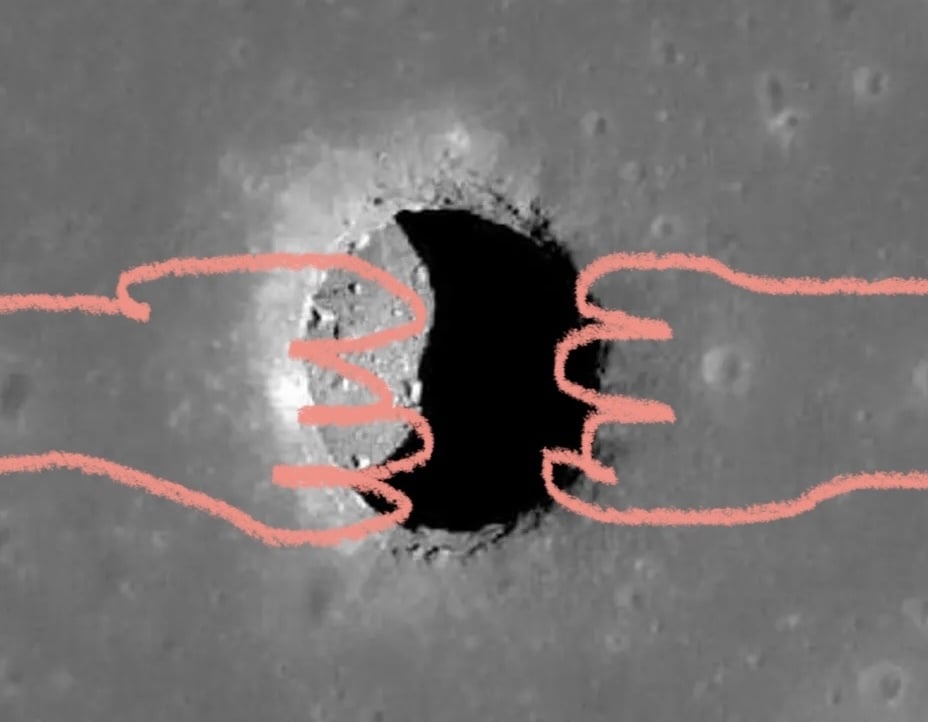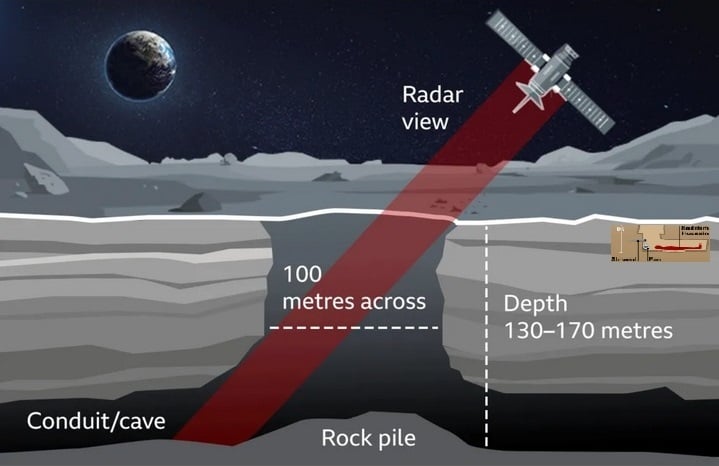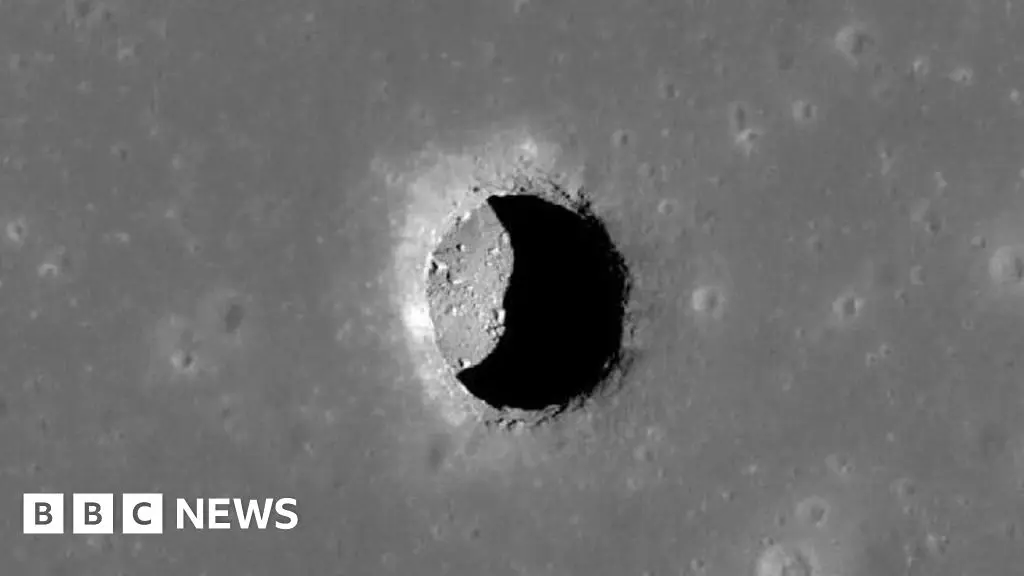- cross-posted to:
- space@lemmy.world
- cross-posted to:
- space@lemmy.world
Scientists have for the first time discovered a cave on the Moon.
At least 100m deep, it could be an ideal place for humans to build a permanent base, they say.
It is just one in probably hundreds of caves hidden in an “underground, undiscovered world”, according to the researchers.
Countries are racing to establish a permanent human presence on the Moon, but they will need to protect astronauts from radiation, extreme temperatures, and space weather.
Helen Sharman, the first British astronaut to travel to space, told BBC News that the newly-discovered cave looked like a good place for a base, and suggested humans could potentially be living in lunar pits in 20-30 years.

Oh you… 🤣
You fucking asshole. How fucking dare you sully the moon like that. Piece of shit. upvotes

missing the wedding ring
The prudes flagging this are making me laugh.
…I still don’t get it…
How. Uh, old are you?
They’re just spreading some joy.
Look up Goatse dot cx
Now if ya dont want to have a bit of old internet shock imagery burned into your mind, well ill summarize by saying spread like a fucking sewer pipe.
Oh God! It’s mooning us!
Username checks out
Fuck. No, please. Just no.
The shadow acts as the wedding band. Accepted.
Next-level mooning.
Just wondering what it means for history if the first humans to start living on the Moon do so in a cave.
Maybe space cavemen?
We’re cavemen on the Moon, we carry bone harpoons! But there ain’t no whales so we tell caveman tales and sing a whaling tune!
Because it’s costly to bring materials and to set up mining operations, a lot of tools will be made of readily available moon rock. So, maybe we’ll have a moon stone age, too.
More, shelter.
There’s no atmosphere to attenuate hard radiation, so rock overhead is the next best thing.
There’s no gravity to contain an atmosphere, and domes are expensive and time consuming to build. Meanwhile the crews are exposed to radiation.
There’s nothing but regolith on the surface of the moon-- finely powdered rock of unknown (and likely poor) assay for vital ores and minerals useful to bootstrap a colony.
A cave provides shelter, more assay-ably dense ore resources, potentially water in the form of subsurface ice, and potentially a vitrable (melted, glassified rock) cavity to contain a viable, pressurized atmosphere on the quick.
A cave on the moon is a find. Given the potential for neocolonialism in the next decade or three, it’s a boon for whatever program discovers one.
edit: typos
The space is a harsh mistress, but also I’m pretty sure all the brochures will have at least one window from where earth is visible.
Even the ones on the far side.
We already have neocolonialism on earth.
I don’t see how the economics of space mining is supposed to work out. We have tons of ore on earth, in existing mines, just sitting there, because it’s more expensive to expand the mine/process less pure ores than the result is worth. It’s not like there’s asteroids of pure platinum floating around.
Lemma: Earth lodes are assumed to be limited supply.
Find a Smaug-scale lode of d-block transition metal like gold or palladium on the Moon or a near-Earth asteroid. Crash the market. Buy other metals at fire sale prices.
Also, own the silicon semiconductor market.
Profit.
We did neocolonialism. It was profitable. Nobody forgot that.
Do we have any reason to believe there’s giant blocks of pure, rare metals on the moon or asteroids? At least on earth we (well mostly China) gets them by processing more common metals and extracting the tiny portion of REs.
We did neocolonialism. It was profitable. Nobody forgot that.
*are doing, is profitable
There’s no brown people on the moon you can give a dictator weapons to in exchange for keeping the people selling their labor and resources for peanuts.
OK fine, we are mid-neocolonial. Accepted.
Do we have any reason to believe there’s giant blocks of pure, rare metals on the moon or asteroids?
So far there’s no evidence to the contrary. Speculative interest says “keep digging, there’s bound to be one out there” among the rocky asteroids. Heck, even “comet water might” bring a price, given trends.
There’s no brown people on the moon you can give a dictator weapons to in exchange for keeping the people selling their labor and resources for peanuts.
If you think the next wave of neocolonialism wouldn’t consider indentured servitude and/or conscription, well… I guess we shall see. You don’t need indigenous people, just poors.
Edit: …when you can just turn off their air.
I don’t tend to look at the moon for mining itself, more as the port from which we can more cheaply and easily head to the asteroid belt where the money is.
Launching stuff off of earth in order to build large structures/ships in orbit is expensive as hell because of the gravity well. Get moon manufacturing off the ground, then everything we build and everywhere we go from there becomes infinitely cheaper (including Mars).
The Moon gives us the solar system. Far more than going direct to Mars ever would.
Not to mention that all the fancy technologies like mass drivers and skyhooks and space elevators are a lot easier to do on the moon.
and domes are expensive and time consuming to build
Also architecturally impossible, since there’s nothing to stop them from flying upwards. Pressure vessels work best when rounded on every side.
Edit: Unless you count a half-buried sphere as a dome.
A cave on the moon is a find. Given the potential for neocolonialism in the next decade or three, it’s a boon for whatever program discovers one.
There’s more of these known BTW. The new thing is just proof that the hole continues underneath like expected.
There’s nothing but regolith on the surface of the moon-- finely powdered rock of unknown (and likely poor) assay for vital ores and minerals useful to bootstrap a colony.
That’s just not true, there’s exposed rocky outcrops as well.
You can get a long way with just the rock-building elements of silicon, iron, aluminum and magnesium, metals-wise (and maybe calcium with no air to bother you). Volatiles are the real prize everyone is after.
Eh. How hard is it to bring a little arc furnace and start making aluminum? Hell, magnesium would be even easier, since hard vacuum is cheap up there.
NoAirBNB
Vacuumbnb
Yet…
Mildly related by the topic. I’m playing ghost recon breakpoint and a bunch of the main characters are hiding in a huge cave. My character said something like “do you have a computer?” And the NPC replied, “I live in a cave, I’m not a cave man” .

I… expected this
Glad to live up to the expectation!
This is the best summary I could come up with:
Scientists have for the first time discovered a cave on the Moon.At least 100m deep, it could be an ideal place for humans to build a permanent base, they say.It is just one in probably hundreds of caves hidden in an “underground, undiscovered world”, according to the researchers.Countries are racing to establish a permanent human presence on the Moon, but they will need to protect astronauts from radiation, extreme temperatures, and space weather.Helen Sharman, the first British astronaut to travel to space, told BBC News that the newly-discovered cave looked like a good place for a base, and suggested humans could potentially be living in lunar pits in 20-30 years.But, she said, this cave is so deep that astronauts might need to abseil in and use “jet packs or a lift” to get out.Lorenzo Bruzzone and Leonardo Carrer at the University of Trento in Italy found the cave by using radar to penetrate the opening of a pit on a rocky plain called the Mare Tranquillitatis.It is visible to the naked eye from Earth, and is also where Apollo 11 landed in 1969.The cave has a skylight on the Moon’s surface, leading down to vertical and overhanging walls, and a sloping floor that might extend further underground.It was made millions or billions of years ago when lava flowed on the Moon, creating a tunnel through the rock.The closest equivalent on Earth would be the volcanic caves in Lanzarote, Spain, Prof Carrer explains, adding that the researchers visited those caves as part of their work.
When you make these discoveries and you look at these images, you realise you’re the first person in the history of humanity to see it,” Prof Carrer said.Once Prof Bruzzone and Prof Carrer understood how big the cave was, they realised it could be a good spot for a lunar base.
“After all, life on Earth began in caves, so it makes sense that humans could live inside them on the Moon,” says Prof Carrer.The cave has yet to be fully explored, but the researchers hope that ground-penetrating radar, cameras or even robots could be used to map it.Scientists first realised there were probably caves on the Moon around 50 years ago.
Then in 2010 a camera on a mission called the Lunar Reconnaissance Orbiter took pictures of pits that scientists thought could be cave entrances.But researchers did not know how deep the caves might be, or if they would have collapsed.Prof Bruzzone and Prof Carrer’s work has now answered that question, although there is much more to be done to understand the full scale of the cave.“We have very good images of the surface - up to 25cm of resolution - we can see the Apollo landing sites - but we know nothing about what lies below the surface.
There are huge opportunities for discovery,” Francesco Sauro, Coordinator of the Topical Team Planetary Caves of the European Space Agency, told BBC News.The research may also help us explore caves on Mars in the future, he says.
That could open the door to finding evidence of life on Mars, because if it did exist, it would almost certainly have been inside caves protected from the elements on the planet’s surface.The Moon cave might be useful to humans, but the scientists also stress that it could help answer fundamental questions about the history of the Moon, and even our solar system.The rocks inside the cave will not be as damaged or eroded by space weather, so they can provide an extensive geological record going back billions of years.The research is published in the scientific journal Nature Astronomy.Graphic by Gerry Fletcher
The original article contains 606 words, the summary contains 603 words. Saved 0%. I’m a bot and I’m open source!
After all, life on Earth began in caves,
Citation please?
Oh boy, finally! For decades, the lack of caves has kept us from living on the moon. No more! We will take those caves. And then we will live the shit out of the moon! Moon cave, baby!
but first you have to kill the bubbul frog
but they will need to protect aronauts from radiation, extreme temperatures, and space weather.
Space weather? Like meator showers?
Since the solar wind would probably be covered by “radiation”, yes.
Yes i believe it has to do with the moons atmosphere or lack there of one. Space rocks won’t burn up like they do on earth and therfore are more likely to strike down.
deleted by creator
That’s no moon.
Hooray, we solved the homeless crisis.
At least 100m deep, it could be an ideal place…
Seems excessively very deep to me - someone’s going to have to build a freight elevator as tall as a soccer field is long. Even worse, I’d expect you’d want your airlock on the surface so you’re not struggling to maneuver in a bulky suit just to get outside: now you’re talking about a 100m pressurized elevator.
Does anyone know how deep you’d ideally want? I’m sure NASA has studied it. I do remember reading that 1’ is the exact wrong number because of indirect radiation. While you get more protection from radiation and a more stable temp, the deeper you go, the marginal value probably drops off pretty quickly, plus the inconvenience would quickly climb. When people online talked about living underground on the moon, I always imagined like 5-10m
Edit: here’s an argument to keep it less than 12m deep
Edit2: and here’s an argument for at least 1-2m
I would design the elevator car to be self-contained, rather than pressurizing the entire shaft.
Actually, it would be more like riding in a pressurized moon rover. Then, using wheels or rollers on opposing sides of a track to act as guides, some kind of hoist, or maybe just a linear inductive motor using the track as a stator plate.
The advantage to the linear induction motor is simplicity- if you’re building the track/guides out of metal any way, then, it’s just a few more components and you have a way to go up, go down, and brake.
In any case there’s really no reason to have a pressurized shaft.
The value of the cave is it’s already there, with no need to excavate that incredibly annoying moon dust. Which, to be clear, is a horribly hazardous material.
Because there’s little to no natural erosion, it’s sharp and splintery and highly barbed. It’s also magnetic, so it sticks to anything made of iron or steel; and for example probably causes something akin to silicosis.
It’s basically the reason that NASA and others are looking at pressurized rovers with suit ports for hopping out instead of an airlock and space suit design. It significantly resizes the amount of moon dust coming in.
Yes, the moon dust. That incredibly abrasive moon dust. Getting into the workings of the elevator that is your only way out of a deep hole. Any any repair work complicated by having todo it in a suit, in a vacuum, in the moondust, at whatever height it finally broke down
Even rabbits are smart enough to build 2 exits in their tunnels if they’re of any size at all. The weather also isn’t a big deal, so a track that’s been cleaned, and doesn’t have moon dust dragged onto it, shouldn’t need cleaning every other week.
deleted by creator
See the link on my first edit. Even in the Moon’s low gravity, a fall over 12m is potentially fatal. It would be foolish to live such that astronauts take this extra risk every day.
You also have to get all your stuff down there in one piece. Sure, more ropes, but tons of equipment, huge sections of living quarters and airlock, construction vehicles, etc. then every supply run needs to get tons of supplies all the way down there. You could do it, but it seems like giving yourself a lot of unnecessary work, taking up way too much time. And of course any sort of cave-in makes any survivors completely unreachable
















